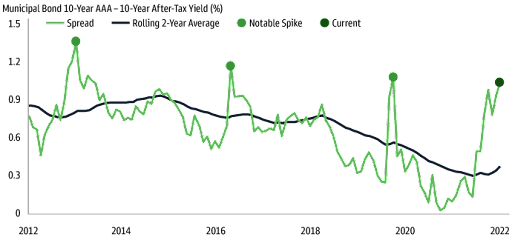The Federal Reserve’s efforts to contain inflation have taken a toll on the bond markets in recent months. Since the beginning of the year, the iShares Core U.S. Aggregate Bond ETF (AGG) is down more than 16%. While that’s better than the S&P 500 Index, it’s significantly worse than simply holding cash in a high-yield bank account.
With the economy heading into a recession, the central bank’s interest rate hikes could slow over the coming quarters. The slowdown in interest rate hikes could help stabilize interest rates, making the bond market more attractive, particularly as a safe haven. And, thanks to its unique characteristics, the municipal bond market looks especially attractive.
Let’s examine why the muni bond market looks so inviting and where investors can seek out the best opportunities.
Be sure to check our Municipal Bonds Channel to stay up to date with the latest trends in municipal financing.
Stabilizing Prices With Attractive Yields
The U.S. economy is showing signs of a cooldown, with the Conference Board predicting a 96% likelihood of a U.S. recession over the next 12 months. Ironically, an economic slowdown could boost bonds by stabilizing interest rates while increasing demand. As a result, bond prices could start to recover after a historic bear market.

Past spikes in the spreads between 10-year AAA muni yields and after-tax 10-year Treasury yields were followed by quick retrenchments (higher prices). Source: Goldman Sachs
At the same time, U.S. Treasury yields are higher than they’ve been in years, with the 10-year peaking at around 4%. The municipal-to-Treasury yield ratio is also much higher than historical averages at about 86%, indicating an attractive relative yield. Tax-exempt income compensation for investors willing to buy now is at historic highs.
Well-Positioned for an Economic Downturn
State and local governments have strong balance sheets thanks to federal pandemic aid packages and a strong economic performance in 2021 and early 2022. With sizable reserves, they are in a much stronger position to weather an economic downturn. For instance, California had a $31 billion surplus and Florida had an $11.2 billion surplus last year.
Meanwhile, state and local tax revenues continue to rise, thanks to positive economic growth. More than 30 states reported higher-than-expected revenue in 2021, according to the National Association of State Budget Officers, with overall state revenue (including federal funds) increasing by more than 12% last year.
Demand Outstrips Supply
The supply of municipal bonds continues to decline, thanks to fewer refunding issues. With robust balance sheets and a sharply higher cost of capital, state and local governments have been slow to issue new bonds at higher interest rates. As a result, the muni bond supply will likely remain tight until interest rates stabilize next year.
While the overall muni market has seen net outflows this year, municipal ETF flows came in at a positive $13.7 billion through September. High after-tax yields could draw in more investors early next year when rates stabilize. And the potential for a U.S. recession could also sharply increase demand as investors seek safe-haven investments for their capital.
Muni Bond Opportunities
The largest muni bond ETFs by assets under management include:
| Name | Ticker | AUM | Expense Ratio |
|---|---|---|---|
| iShares National Muni Bond ETF | MUB | $28.9 Billion | 0.07% |
| Vanguard Tax-Exempt Bond ETF | VTEB | $20.8 Billion | 0.05% |
| iShares Short-Term National Muni Bond ETF | SUB | $9.1 Billion | 0.07% |
| SPDR Nuveen Bloomberg ST Muni Bond ETF | SHM | $4.6 Billion | 0.20% |
| SPDR Nuveen Bloomberg Muni Bond ETF | TFI | $3.3 Billion | 0.23%< |
Data as of November 1, 2022
The Bottom Line
The bond market experienced an unprecedented drop over the past few months, but stabilizing interest rates could lead to a recovery. In particular, municipal bonds could see a strong recovery as investors seek a high-yield safe-haven investment during the upcoming recession. As a result, investors may want to check out muni mutual funds and ETFs for their portfolios.
Sign up for our free newsletter to get the latest news on municipal bonds delivered to your inbox.





